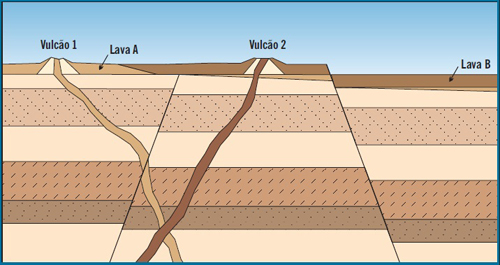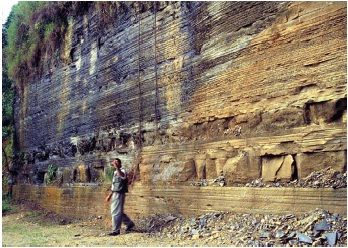Idade da pedra EarthCache
-
Difficulty:
-

-
Terrain:
-

Size:  (other)
(other)
Please note Use of geocaching.com services is subject to the terms and conditions
in our disclaimer.
[PT]
Para logares responde por e-mail ás seguintes questões.
Após enviar o e-mail pode logar a earthcache. Caso seja necessário entrarei em contacto.
1 – Quais os dois princípios que se podem observar na parede de descida?
2 – Qual a altura aproximada dessa mesma parede?
[EN]
To make a log, respond by e-mail to the following questions.
After you send the email you can log the EarthCache. If necessary I will contact you.
1 – What are the two principles that can be observed in the wall of descent?
2 – What is the approximate height of that wall?
[PT]
Quando se fala da idade de uma rocha, pode-se falar de idade absoluta ou de idade relativa.
[EN]
When talking about the age of a rock, we can speak of absolute age or relative age.
[PT]
A sua idade relativa não nos diz à quanto tempo a mesma se formou, mas sim se a mesma se formou antes ou depois de outra rocha ou de um evento geológico baseando-se em princípios.
[EN]
Their relative age does not tell us about the time she was born, but if formed before or after another rock or a geological event based on principles.
[PT]
Princípio da sobreposição - diz que numa sequência de camadas a camada do meio é mais nova que a camada abaixo e mais velha que a que se encontra por cima da mesma.  Isto devido ao facto das rochas sedimentares serem formadas pela deposição de sedimentos (cascalho, areia, argila, etc.) ao longo do tempo, trazidos por agentes transportadores como as águas e o vento. Esse material vai sendo empilhado e naturalmente quanto mais em baixo ele estiver na pilha mais antigo é.
Isto devido ao facto das rochas sedimentares serem formadas pela deposição de sedimentos (cascalho, areia, argila, etc.) ao longo do tempo, trazidos por agentes transportadores como as águas e o vento. Esse material vai sendo empilhado e naturalmente quanto mais em baixo ele estiver na pilha mais antigo é.
[EN]
The principle of superposition - says that an sequence of layers, the middle layer is newer than the layer below and older that is found above it. This because of sedimentary rocks was formed by deposition of sediment (gravel, sand, clay, etc.) over time, carried by agents such as water and wind. This material is being stacked and how much more below he is on the stack more old will be.
[PT]
 Princípio das relações de intersecção – Qualquer rocha que foi cortada por um corpo intrusivo ardente ou por uma falha é mais antiga que o corpo ou a falha. Se uma rocha é atravessada por outra rocha de natureza ardente (ex: veios de quartzo), essa rocha ardente é mais recentes que a rocha que foi cortada.
Princípio das relações de intersecção – Qualquer rocha que foi cortada por um corpo intrusivo ardente ou por uma falha é mais antiga que o corpo ou a falha. Se uma rocha é atravessada por outra rocha de natureza ardente (ex: veios de quartzo), essa rocha ardente é mais recentes que a rocha que foi cortada.
[EN]
Principle of the relationships of intersection - Any rock that was cut by a burning intrusive body or a failure is older than the body or failure. If a rock is crossed by another rock fiery nature (eg quartz veins), this burning rock is more recent than the rock that was cut.
[PT]
 Princípio da horizontalidade original – as formações sedimentares são depositadas originalmente na posição horizontal. Por mais irregular que seja a superfície onde os sedimentos se começam a depositar, as formações originadas por eles serão horizontais ou quase horizontais.
Princípio da horizontalidade original – as formações sedimentares são depositadas originalmente na posição horizontal. Por mais irregular que seja a superfície onde os sedimentos se começam a depositar, as formações originadas por eles serão horizontais ou quase horizontais.
Este princípio estabelece que qualquer fenómeno geológico que altere a horizontalidade é sempre posterior à sedimentação.
[EN]
Principle of original horizontality - the sedimentary formations are originally deposited horizontally. For more irregular is the surface where sediments begin to deposit, formations caused by them are horizontal or almost horizontal.
This principle establishes that any geological phenomenon that changes the horizontality is always posterior to sedimentation.
[PT]
Princípio da continuidade lateral original – sequências estratigráficas idênticas expostas em lados opostos de um vale devem ser interpretadas como restos de camadas que já foram contínuas na área em que o vale foi aberto. Ambas as camadas apresentam a mesma ordem e as mesmas características, mostrando que eram contínuas e foram desgastas pela passagem do rio.
[EN]
Principle of original lateral continuity - stratigraphic sequences identical exposed on opposite sides of the valley to be interpreted as scraps which have been continuous layers in the area where the valley has been opened. Both layers have the same order and the same characteristics, which were continuous and were opened by the passing of the river.
[PT]
Já a idade absoluta diz-nos com maior ou menor grau de certeza, há quantos milhões ou biliões de anos a rocha se formou, através de dois processos distintos, tais como o estudo do seu conteúdo fossilífero. Este estudo tem algumas limitações pois iguala a idade da rocha à idade dos fósseis nela encontrados, contudo existem fósseis que viveram durante um vasto período de tempo dando uma margem de idade larga ou no caso de rochas magmáticas que não contém fósseis este estudo não revela resultados e para tal poderá ser usado o outro método de estudo que se baseia na datação radiométrica.  Processo esse que usa a radioactividade de certos minerais que constituem a rocha para determinar a sua idade. No laboratório, através de aparelhos chamados espectrómetros de massa, consegue-se determinar os elementos químicos radioactivos (Urânio, Tório, Rubídio, Potássio) contidos nessas rochas e os elementos químicos estáveis (Chumbo, Estrôncio e Árgon) que resultaram da desintegração dos elementos radioactivos. Como se conhece o tempo de duração da desintegração consegue-se determinar a idade da rocha. Quanto mais velha é uma rocha menor é a razão entre os elementos radioactivos e os estáveis, porque os radioactivos já se desintegraram para dar origem aos elementos químicos estáveis.
Processo esse que usa a radioactividade de certos minerais que constituem a rocha para determinar a sua idade. No laboratório, através de aparelhos chamados espectrómetros de massa, consegue-se determinar os elementos químicos radioactivos (Urânio, Tório, Rubídio, Potássio) contidos nessas rochas e os elementos químicos estáveis (Chumbo, Estrôncio e Árgon) que resultaram da desintegração dos elementos radioactivos. Como se conhece o tempo de duração da desintegração consegue-se determinar a idade da rocha. Quanto mais velha é uma rocha menor é a razão entre os elementos radioactivos e os estáveis, porque os radioactivos já se desintegraram para dar origem aos elementos químicos estáveis.
[EN]
Already absolute age tells us with greater or lesser degree of certainty, how many millions or billions of years the rock was formed by two different processes, such as study of its contents fossiliferous. This study has some limitations because it equals the age of the rock at the age of the fossils found, however there are fossils that lived for a long period of time giving a wide margin of age or in the case of magmatic rocks that do not contain fossils this study does not reveal results and such can be used another method based on the study of dating radiometric. This process uses the radioactivity of certain minerals making up the rock to determine its age. In the laboratory, using devices called mass spectrometers, it is possible to determine radioactive chemical elements (uranium, thorium, rubidium, potassium) contained in these rocks and the chemical elements stable (Lead, Strontium and Argon) resulting from the disintegration of radioactive elements. As we known the duration of the disintegration we can determine the age of the rock. How much more old is a rock lower is the ratio between the stable and radioactive elements, because radioactive already disintegrated to yield the stable chemical elements.



Additional Hints
(No hints available.)